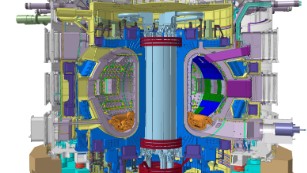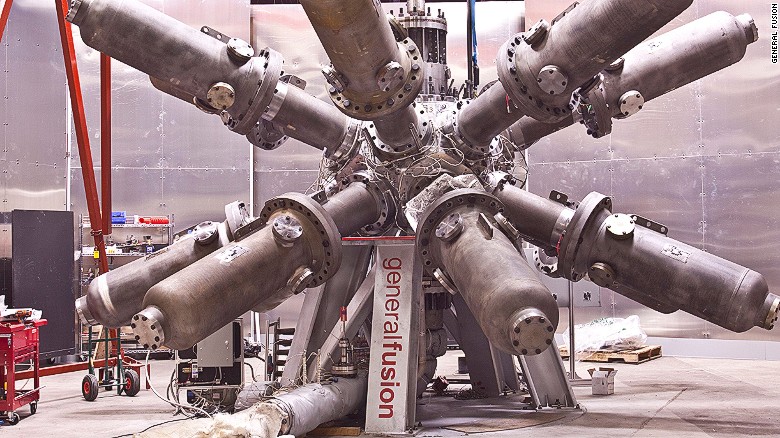We believe the answer is yes, as we believe cold fusion nuclear is part of the answer, too.
Is nuclear fusion about to change our world?
(CNN)Hey 21st century, where's that nuclear fusion power reactor you promised?
Tens of billions of dollars have been spent in the past 60 years, entire careers have been invested, but the ability to produce a commercially viable nuclear fusion reactor remains undemonstrated.
After beating our heads against the wall for so long, you might ask: Why keep trying?
Because on paper, fusion has the potential to save the planet.
Imagine a world powered by a cheap, safe, clean, virtually limitless, sustainable fuel source such as water. If fuel and energy are cheap and available to all nations, that reduces global political tensions. If our energy comes from a clean-burning fuel source, that reduces air pollution. All that would be good, right?
Billionaires such as Amazon founder Jeff Bezos, PayPal co-founder Peter Thiel and Microsoft co-founder Paul Allen apparently think so.
They've each thrown their money into a different fusion development company, each with its own idea how to solve the fusion puzzle, according to Forbes.
"What we're really doing here is trying to build a star on Earth," said Laban Coblentz at the International Thermonuclear Experimental Reactor (ITER), a massive fusion reactor being built by 35 countries in southern France.
When Coblentz said "star," he meant that quite literally. Fusion is what keeps stars, including our own sun, burning bright.
Oversimplified, of course, here's how fusion is supposed to work:
You take two gases called deuterium and tritium and you heat them under pressure to at least 100 million degrees Celsius. That's 180 million degrees Fahrenheit. These substances will get so hot that they change from gas to plasma. Then they fuse together -- releasing a burst of additional heat. That burst is called a fusion reaction.
The heat boils water into steam, which drives a turbine and generates electricity that powers your neighborhood.
Here's the really important thing: To be commercially viable, you have to create more energy than the original energy you used to heat the fuel.
And there's the rub: We haven't been able to figure that part out.
The ITER project in Cadarache, France, aims to do just that.
Five years after construction began, activity is ramping up to a higher level. Several 33-foot-tall, 86-ton drain tanks have recently arrived from the United States. Workers have been busy gathering components to build giant electromagnets that Coblentz called the "largest superconductor procurement in the history of the planet."
The mood at Caderache is hopeful, Coblentz said. "There's a very palpable sense that at last we're entering this phase where we're seeing physical change," he said. "We're seeing the progress of the project."
But design changes and construction delays have resulted in rising costs. One estimate says the project will cost $21 billion by the time it's expected to be finished around 2020. U.S. contribution: $3.9 billion.
"The real question is can the organization work in an internationally harmonized way and be reliable and stick to the schedule. .. I'm confident that it really is going to happen. We're going to be surprising a lot of the skeptics."
ITER recently cut the ribbon on a nearly 200-foot-tall Assembly Building, one of the first massive structures at the site. Inside, workers will piece together large reactor components before they're inserted into the main facility that houses something called a tokamak.
A tokamak is a doughnut-shaped vacuum chamber surrounded by electromagnets. It's designed to hold the plasma in place with the help of a magnetic field. If the plasma can be held in place long enough, the heat and pressure will create a fusion reaction.
What's so hard about fusion?
Handling plasma is one of the big challenges that make fusion so hard. To achieve fusion, you have to bottle up that super-hot plasma so it's really dense. Then you have to keep it dense, hot and contained long enough to get it to fuse.
The billionaires such as Allen, Thiel and Bezos have put their money into private companies that are running projects on a much smaller scale than ITER.
Allen is reportedly an investor in a firm called Tri-Alpha Energy, in Orange County, California. Thiel is said to be backing Helion Energy in Redmond, Washington, and Bezos has his hopes riding on an outfit called General Fusion in the Canadian town of Burnaby, British Columbia.
All these companies are using electromagnets in their attempts to unlock the promise of fusion.
But others are trying methods that don't rely on electromagnets.
In Livermore, California, the National Ignition Facility has been focusing on a process called inertial confinement fusion.
Here's how it works: You take a pellet filled with deuterium and tritium gas and place it inside a gold plated cylinder. Then you shoot it with intense laser light. The light heats the inner walls of the cylinder, creating a superhot plasma that showers the pellet with soft X-rays. The X-rays heat the outer surface of the pellet, causing it to implode. The implosion compresses and ignites the plasma and burns the fuel, causing a fusion reaction.
Experts say science has made a lot of progress recently and for some, confidence is high.
"For $20 billion in cash, I could build you a working reactor," Professor Steven Cowley, CEO of the UK Atomic Energy Authority, told Popular Mechanics. "It would be big, and maybe not very reliable, but 25 years ago we didn't even know if we'd be able to make fusion work. Now, the only question is whether we'll be able to make it affordable."
Nonetheless, it's unlikely the big push for fusion will disappear altogether, as long as it promises to solve the world's energy needs for the next millennium.
"Sure. It would solve that. There's no question," Coblentz said. "We just have to demonstrate it, and then replicate it on a scale that will actually be practical."



No comments:
Post a Comment